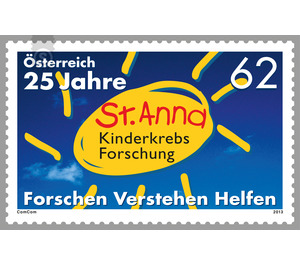25 years - Austria / II. Republic of Austria 2013 - 62 Euro Cent
Theme: Health & Human
| Country | Austria / II. Republic of Austria |
| Issue Date | 2013 |
| Face Value | 62.00 |
| Edition Issued | 400,000 |
| Printing Type | offset |
| Stamp Type | Commemorative |
| Item Type | Stamp |
| Chronological Issue Number | 2414 |
| Chronological Chapter | OOS-OE2 |
| SID | 402435 |
| In 56 Wishlists | |
The idea of setting up a separate research institute for children with cancer in the St. Anna Children's Hospital in Vienna's 9th district originally came from affected parents whose children had cancer and were treated in a hospital there. They support those of Univ. Prof. Dr. Helmut Gadner recognized the need for childhood cancer research in order to be able to help the young patient even more efficiently. In the autumn of 1986, the association "Research Institute for Children with Cancer" was launched and with the help of the media launched a large-scale fundraiser. The donations made by the population made it possible to expand corresponding laboratories in the vacant attic of the St. Anna Children's Hospital. Finally, in June 1988, exactly 25 years ago, the institute commenced research. Since then, outstanding scientific achievements have been made here that are highly regarded worldwide and benefit all children and adolescent patients. In 2006, the somewhat long-run club name was changed to the short version "St. Anna Childhood Cancer Research "changed. A key point in the scientific work of the institute is undoubtedly the development and adaptation of molecular biological and immunological methods, which allow the identification of diagnostic or prognostic factors in leukemias and solid tumors of childhood faster and more reliably than conventional approaches. These technologies have been extensively tested in labs for their usefulness in clinical practice. Finally, the use of the new methods resulted in many cases in which the treatment could be better adapted to the biology of the disease. For the future, this certainly means that the individual situation of the adolescent patient can be better taken into account in the treatment. In the field of bone marrow transplantation, however, research has been instrumental in enabling this important and often unique therapeutic procedure to be applied far more quickly and more accurately than before. Due to the tissue intolerance, the biological parents as bone marrow donors for their children were previously out of the question and it was dependent on third-party donors; Unfortunately, the search for these did not lead to the desired success in many cases. Recent advances in research, however, have created the ability to prepare a parent's blood in such a way that it can be used for bone marrow transplantation. This represents an important step on the way to better survival of children with cancer. One thing is certain: The daily interaction between the treating physician, basic and applied research in the St. Anna Children's Hospital is the optimal basis for effective patient assistance.


